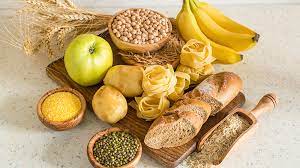Carbohydrates
Carbohydrates are the organic compounds i.e. essential biomolecules composed of carbon ,hydrogen and oxygen. The hydrogen and oxygen are in the ratio of 2:1 so they are also called "Hydrates of C...

Proteins are the most complex chemical compounds formed of C,H, O,N,(sometimes S and P).
On the basis of of chemical nature, proteins are divided into three categories:
Simple proteins

Fig: Histone
Simple proteins are made up of only amino acids. Non -amino groups are totally absent. These are formed of peptide chains and yield only amino acids on hydrolysis. For Example: globulins, albumins, histones and protamine.
Conjugated proteins

Fig: Lipoprotein
These proteins consist of amino groups and non- amino groups. The non- amino groups are also called prosthetic groups. Prosthetic groups are the non- proteinous groups such as nucleic acid, phosphoric acid, lipid etc.
Some examples of conjugated proteins are as follows:
Glycoprotein: They are formed by the combination of protein and glucose. They are found in mucin of saliva and cell membranes.
Phosphoproteins: They are by the combination of amino acid and phosphate. They are found in milk in the form of casein.
Lipoproteins: They are formed by the combination of amino acid and lipids.They are basic composition of biological membranes.
Nucleoproteins: They are formed by the combination of amino acids and nucleic acid . They are found in the chromosome of a cell.
Chromo proteins: They are formed by the combination of amino acid and coloured pigment it contains Fe, Cu, Mg or Cobalt. They are found in haemoglobin and retina of eye.
Derived protein

Fig: Fibrin
Derived proteins are obtained from simple or conjugated proteins by denaturation coagulation and heating. For example: Peptones (Soluble protein formed at early stage of protein breakdown during digestion)Meta protein (Protein formed through action of acid and alkali)Proteases( Formed by hydrolytic breakdown of protein during digestion Fibrin (Protein that involve in coagulation of blood)
On the basis of shape proteins are of two types:
Fibrous protein

Fig: Collagen
They are thread-like, rough, non-enzymatic structural proteins that are insoluble in water and generally have secondary structure. Example : keratin (skin or hair), Myosin(muscles),
collagen (connective tissues)
Globular proteins

Globular proteins consist of one or more polypeptide chains of alpha helix configuration and are oval and spherical in shape. For example: Albumin (egg), Glutelin (seed), Myoglobin (muscles)
Similarly on the basis of function proteins are are of two types
Enzymatic proteins
They function as enzymes. For example: Amylase (they help in hydrolysis of starch), Pepsin ( they help in breakdown of protein into smaller pieces)
Non-enzymatic proteins
Structural protein: They form part of cellular protoplasm. For example: Keratin, collagen etc.
Reserve Protein: They reserve food. For example: Amylase, Lipase etc.
Please Log In to ask your question.

simple protein ma yeuta matra amino acid hunxa then peptide chain kasari hunxa ne??
Well you have mistaken it. Actually simple acids have only amino acid doesn't mean that they are composed of single amino acid only. It means they are composed by combination of many amino acids linked by peptide bond but consist no any external components like fats, starch and so on.
Hope you are clear now!